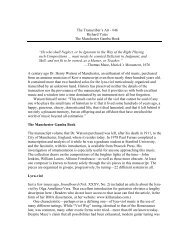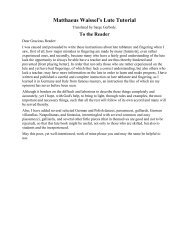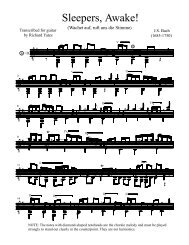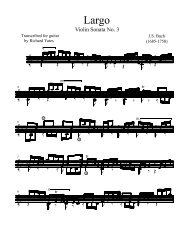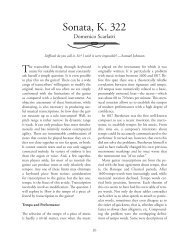The Transcriber's Art - Richard Yates Classical Guitar Transcriptions
The Transcriber's Art - Richard Yates Classical Guitar Transcriptions
The Transcriber's Art - Richard Yates Classical Guitar Transcriptions
Create successful ePaper yourself
Turn your PDF publications into a flip-book with our unique Google optimized e-Paper software.
<strong>The</strong> Transcriber’s <strong>Art</strong> - #40<strong>Richard</strong> <strong>Yates</strong>Pavane, Op. 50 by Gabriel Fauré“<strong>The</strong> guitar is a small orchestra. It is polyphonic. Every string is a different color, a differentvoice.” –Andrès SegoviaPerhaps Segovia was the first to make this observation, or maybe it was Hector Berlioz—also a guitarist. Regardless of the attribution, it is true that the variations in tonal color of whichthe guitar is capable are a substantial source of its charm and versatility. But does that meanthat the guitar is suited for playing music written for orchestra? Well, there is that qualifyingword “small” in the Segovia quotation and, of course, there lies the difficulty: Orchestras, evensmall ones, are much larger than guitars—and the sound they can produce—in nearly anydimension you care to measure. However, this has not deterred all guitarists. <strong>The</strong> performancesof orchestral music by such players as Kazuhito Yamashita and, more recently, Jorge Caballeroare astonishing. But these Olympian accomplishments do more to impress us with theirsuperhuman technique than to assure us that playing orchestral music on the guitar is feasiblefor the average player. Indeed, to hear Yamashita’s Beethoven or Caballero’s Dvorak can besimply discouraging for transcribers looking to expand the guitar’s repertoire.And yet close examination of some orchestral scores can reveal a simpler compositionalstructure than is apparent from the sound that is produced. After all, in the period of harmoniccommon practice orchestra composers put together their progressions one triad at a time just asthe guitar composers did. And so, barring dense polyphony for which we have too few fingersand strings, we can find reasonable pieces for transcription. In searching this far afield, somewill be less comfortable with the term “transcription” than with “arrangement” but, in anyevent, the boundaries of these terms are fuzzy and a practical and musical result is what is mostimportant.I recently heard Gabriel Fauré’s Pavane in F sharp minor, Op. 50 performed by a brassorchestra at a concert to raise money for the victims of last spring’s earthquake in China. JayChen, of Willamette University, recruited and organized members of the Columbia Symphony,Portland Opera, Oregon Symphony, Portland Ballet and regional universities. <strong>The</strong> success ofthat arrangement and performance prompted me to look at the score to see if a guitar versionwere possible.<strong>The</strong> Pavane was written for a series of light summer concerts in 1887. Happily for thetranscriber, it employs a smallish orchestra consisting of strings plus pairs of flutes, oboes,clarinets, bassoons and horns, although Fauré added a chorus shortly before the firstperformance. <strong>The</strong> versions with and without chorus have both been performed regularly eversince. Fauré had a strong ambivalence about the orchestra. He wrote only a handful of worksfor large ensembles and abandoned or destroyed several orchestral scores, yet he alsocomposed music for immense ensembles—Prométhée is scored for three wind bands, 100strings, 12 harps, and choirs. His biographer, Jean-Michel Nectoux wrote, “He had a horror ofvivid colours and effects, and showed little interest in combinations of tone-colours, which hethought were too commonly a form of self-indulgence and a disguise for the absence of ideas”and “Fauré’s lack of interest in the orchestra is sometimes criticized as a weakness…”
In this context, the Pavane is interesting because it seems to be a deliberate exercise inorchestral color, much as Ravel’s Bolero was. <strong>The</strong> main melody repeats in turn on differentinstruments or their combinations. This structure presents both the opportunity and thechallenge for a guitar transcription. <strong>The</strong> guitar, uniquely among instruments, can color theserepetitions with a range of timbres, articulations and dynamics and, in so doing, sustain interestover the extended form. I do not recommend trying to imitate the actual original instrumentsbut, rather, to experiment with different sounds to find the ones that best fit the music, theinstrument, and the player.<strong>The</strong> size of the original ensemble is daunting as you can see in Figure 1. Yet, after sortingthrough the maze of clefs and transposing instruments, a basic structure is revealed that iswithin the reach of the guitar. Figure 2 shows all of the notes of the original score combinedonto only four staves. <strong>The</strong> octave duplications are then eliminated and a more felicitous keychosen. <strong>The</strong> line that combines the first violins and the horns is just a bit more than can bemanaged on the guitar and, because it has no essential harmonic tones not present in othervoices, it was omitted. <strong>The</strong> result is shown in Figure 3—not quite ready for the guitar butcertainly very close. <strong>The</strong> measures in these examples are the densest of the whole piece andwere chosen to show how much reduction is both possible and necessary. A similar procedurewas used throughout the transcription.Flutes, Clarinets,Bassoons, VoicesViolins II,Violas#& ##cœœœ#& ##c ‰œ.œœ.œ œ œœœœœœœ‰œœ.œœ.œœœœœœœœ‰nœnœnœœœœœœœœœœœœ.œ.œ œ œ ‰ œ nœœœœœCellos,Contra-bassesViolins I,Horns? # ## cœœ#& ##c ÓŒnœnœ˙ŒœœŒœœœ ˙ œŒFigure 2ReductionV # cœ . œ œ œ.œ‰ œ œ œ ‰ œ œ œœ Œ œ Œœ n œ œ œ.‰ œ œ œ ‰ œ nœœ Œ œ ŒœœFigure 3
2 Flutes#& ##cœ œ.œ œ œ.œœ nœœ œ œ œ.œ2 Oboes#& ##c∑∑2 Clarinets in A&cœ œ.œ œ œ.œœ bœœ œ œ œ.œ2 Bassoons? # ## cœ œ.œ œ œ.œœ nœœ œ œ œ.œ2 Horns in F#& ##cÓ˙œ ˙ nœSopranosAltosTenorsBasses#& ##c#& ##c#V ##c? # ## cÓ œ .J œCommeÓjœ œ .CommeÓ œ .J œÓCommeœ .J œR œonR œonR œonR œœ œ œ œ œ . œo se ré - gner surœnœœ œ œ œ.o se ré - gner surœœ œ œ œ . œo se ré - gner surœnœœ œ œ œ.œœœœViolin IViolin IIViola#& ##c#& ##cB # ##cÓ‰œ œ œComme˙‰œ‰ œ œ œ ‰ œœœœœono se ré - gner surœ˙ œ‰œ‰ œœ œ‰œœ œ ‰ œnœnœœœCelloContra-Bass? # ## ct # ## cœœŒŒnœnœŒŒœŒœŒœ Œ œ ŒFigure 1A few details and suggestions follow:Measure 1: I kept the explicit pattern of a quarter note plus a quarter rest in the bass andsuggest that these rests be observed literally rather than allowing the bass notes to ring through.Later in the piece I changed the line to half notes for textural variety and to simplify fingering.Measure 20: This is the first appearance of triplet eighth notes in the melody against regulareighth notes in the middle voice. While these can be awkward for players unfamiliar withthem, there are a couple of ways to proceed. One is to break the quarter note beat down into sixsixteenths and practice it slowly until the feel for it is established. A second method is to focuson the melody, play the triplet in correct time, and then simply insert the second eighth note ofthe bass line in between the second and third triplet eighth notes in the melody. In practice itwill fall in about the right spot, and familiarity will help smooth it out.
Measure 25: I included a suggested performance of the trill that gradually increases the speedof its alternations. Many other methods are possible including an unmeasured cross-string trillfor those players with sufficient technique. In the original score this trill extended over twomeasures with the same harmonic underpinning but was too difficult to sustain on the guitar.Notice that the trill in measure 62 is the same although the bass line is slightly different.Measure 34: In order to create more variety in the return of the main melody, I thickened themiddle voice to include notes on each eighth beat. This substitutes a textural variation for theorchestration. It sounds best if the middle voice—which at this point is new to the listener—isplayed out more loudly than the upper melody—which is by now familiar.Measure 42: This section is a series of three repetitions of a four measure contrapuntal phraseeach a whole step lower than the previous one. <strong>The</strong> way in which Fauré links these together istypical of his use of rapid modulation. In the original score the first phrase is repeated. Withoutthe resources of the orchestra this seemed too static and so I shortened it by deleting therepetition.Measure 63: Fauré added variety here with a new accompanying line assigned to the cellos. Inthe guitar transcription it weaves between the melody and the quarter note basses. As in thesection at measure 34, playing this voice prominently over the melody adds to the interest.If you have examples or suggestions for our small orchestra please send them to:<strong>Richard</strong> <strong>Yates</strong>richard@yatesguitar.comhttp://www.yatesguitar.com
22V #3œœ# œ œ.‰ œ # œ œ ‰ œ nœœ J œ JŒ Œjœ3œœ# œ œ.‰ œ # œ œ ‰ œ nœœ J œ JŒ Œ42jœ-4˙Œ‰ 1 œ œ JœII3 œ ‰œ œŒ J3œœœœŒ25V ## Ÿ 3 3wœ œ œ œ œ œ‰ J œ œ œ œwœFœ œ œ œ œ # œ œII h IIIœ . œ œ . œ‰ œ œ œ ‰ œ œ œœ J JŒœ Œpœ œ II . œ‰ œ œ œ ‰ œ œ œœ J Œ œ J Œ28V #31œ œ 2 . # œ‰J œ œ œ ‰J œ œ œœ Œ œ ŒV # œ œ œ . œ œ œ nœœ œœ Œ œŒF34V #1œ .œ œ œ œ˙II IIIœ œ3 2œ˙œ. 4œ3œ œw‰ # œ œ œ ‰œ œ œ œJ œ JŒ Œœ œ œ nœ.œ œŒj#œœ œ œ- 4œII 5œ œ. œœ œ œ œ1 œ œ œ œ˙ ˙. œ . œœ œ œ œœ œ œ œœŒ œ Œp˙Ó# œ œ œ œ œ œ œœ Œ Óp21œ4 œ 4 œ. œœ œ œ œ œ œ œ œ #2˙˙37V #40V #w # œ œ œ œ œ œ œ œ˙ ˙IIIœœ˙IIœ œœ œ# #œœœ œ nœœ œ˙IIIœ. œ VII œ . œœ œ œ œ œ œ œn˙œ˙p˙ Óœ œ œ œ œ œ œ œwpV 3.œ nœœ œœ œ œ œ œ œ˙ ˙f2j4œœ œŒ ‰ œ œ œ œœ Œ Óƒ43V #IIIœŒ˙œœœ Œœ 4œ œœœ œ 3 œ21-23IIœ œ œ 4œœ œ œ œ œ ˙ œ1œIII2 œ4œœ˙ 2œ 1œ œœ œ œœ 4 2œ œ3œ35
46V # bœ.œ..b œ.ƒ49jbœœ œnœœ œ œ‰ ÓIœŒb˙V # 23˙œœ 22n1œ 1b4œ- œ14 1bœ œ œbœœ œ1œF52IV # 4 bœbœ2œ œ˙bœ3œ œ bnœ2bœnœFrit.55V #3œ. # œ#œ‰1 œ œ ‰œ œ J œŒJ œ32 œ œ# œŒ1 œœŒœœ bœœ œœnœœ œI jb b ‰ bœœœ nœbœœ œ œbœŒ Óƒb˙œnbœ-24 œ3dim.œ‰3œ2 œbb4œœ œ23 œ œ œœ œ œœ421J œ œ œŒœ4#œ.‰1#2œJ œ422j#œœŒ2œbœœIIIœŒb˙nœ˙ œ œœ œ œ nœ bœœrit.œ bœœ Œbœ4 œ œnœbœœ œn Ó˙‰ œ j œ œ œ œ œ œÓpœ . # œnœœ œ‰ # œ œ œ ‰ nœœœœJ1Œ œ J Œ358V #œ œ œ œ.j‰ #œœ œ œ ‰ J J œ œ œœ œŒ Œ3œœ# œ œ.‰ œ # œ œ ‰ œ nœœ J œ JŒ Œjœ3œœ# œ œ.‰ œ # œ œ ‰ œ nœœ J œ JŒ Œ4jœ61V #64V #67V #3-4˙.œ‰ œœ œ œ œ ‰ J œ J œ œ œŒ ŒIIœ œ œ 0 4 3œ. œ œœœ œ œ œŒ œŒIIIœœ . œ œ œœ ŒVIIœ œnœ2œ œ 34œ. œœ œŒ# Ÿ 3 3wœ œ œ œ œ‰ œœ œ œ œ œw Jfœ œ œ œ œ# œ œ2œ1œ œ œ œ œ . œœ œ œ œ #3œ Œ œ Œœ œ œ œ œ œ.œœ. J œ œ nœœ œ œŒ œŒII III 5 54 .œ . œœ œ œ œ œ # œ œ œœœ Œ Œpw # œ œ œ œ # œ œ # œœ Œ œ ŒIIIœII4 œIVœ. œ œ #œJ œ œ# œ# œœ Œ œœ
70VV # # wœ# œ œ œ nœœ Œ Óß pbœœ œIIœ œ # œœnœœœŒ œIV#œ# œ œ# œV# wœ# œ œ œ nœœ Œ Óß pbœœ œ73V #22œœ76V # -4œœ3VIIœ 3œ œ# œ nœ# œ#œœ œ3 2Ó œ Œœ œ 4Œ21‰ œ œ œ Jœ œ.j‰ œ œ œ˙ Jw˙‰ œ œ œ ‰ œ œ 4 ˙œπ J J3œœ œ œ.j‰ œ # œ œ ‰ œ œ œ˙ J ˙ JII 3œ œ.œ œ œ œ œ˙‰ œ œ œ ‰˙œ œ œJ J3œœ 3 œ -3œ II.j‰ œ # œ œ ‰ # œ # œ œ˙ J J˙79V #œ œ # œœ Œ Ó30 42œœ1 œ#œ33œ œ œ3œ œ œ˙Œœ 1˙˙ œ4œ2œ6πrit.-4-2œœ22 œ œ.‰˙pIVœ œ œ. 4œ4J œ œ œ ‰ œ # œ#˙ œ J82V #21œ‰˙3J œœœ.œ œ .œ ‰J œ # œ œ˙œœ -4‰˙œ œ œJ œ œ œ#˙‰3J œ3œ œ# œ œ384V #33IIII2œœ œ œ 1œ2 œ 4œ-2# œ # œ ˙4‰1J œ œ œ ‰J œ # œÓœ ‰ œ œ œ ‰1˙˙J œ # œ œœœ ‰ œ œ œ ‰˙ ˙ J J J œ # œœ œŒ œ ŒπVII87V # ˙ Óœ ˙4œœ œ œ œ Ó #4œ ˙ œ œ œ˙˙Í . . .œ. œ 2Œ œ Œ ˙ œ 33Œ œ. .œ 1. .œ œ . .œ œrit. . .œ Œ œ Œœ˙ œ ŒœŒ Óœ Œ Ó. .∏


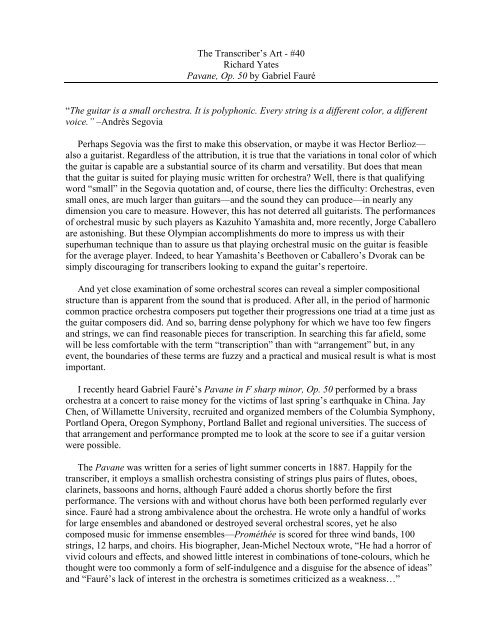

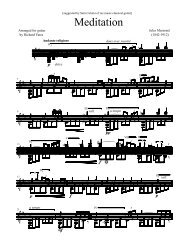
![Finale 2005b - [BWV846-Prelude in C.MUS]](https://img.yumpu.com/43978887/1/190x245/finale-2005b-bwv846-prelude-in-cmus.jpg?quality=85)
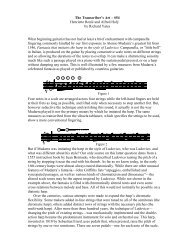
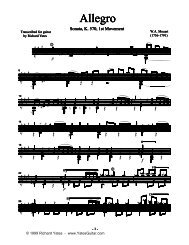

![Finale 2005b - [AirG-TAB.MUS] - Richard Yates Classical Guitar ...](https://img.yumpu.com/37104901/1/190x245/finale-2005b-airg-tabmus-richard-yates-classical-guitar-.jpg?quality=85)

